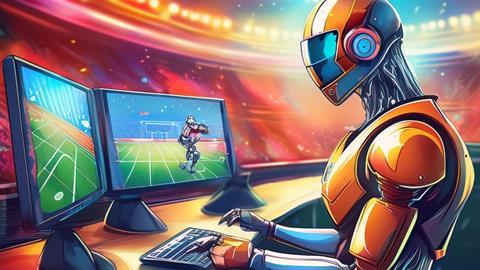Matt Stagg explains why we should embrace AI and GenAI and treat it as a friend, not a foe

The world of sports broadcasting is experiencing a radical transformation, powered by the rise of AI and GenAI. These technologies are set to redefine how live events are captured, processed, and delivered, offering fans more immersive and personalised experiences, whilst helping to tackle long-standing industry challenges such as piracy and accessibility.
Alongside this, AI offers production teams new opportunities to focus their creative energy by offloading the more mundane, manual tasks, thus safeguarding jobs and fostering innovation.
AI-powered tools can select optimal camera angles, track players, and generate real-time commentary. These advancements enable broadcasters to deliver more content for a wider range of sports, at a fraction of the cost.
By offloading repetitive and time-consuming tasks to AI, production teams are free to focus on creativity and storytelling.
This shift protects jobs by allowing individuals to harness their talents in more meaningful ways, while AI handles the routine work.
The blend of human expertise and machine efficiency ensures that the quality of the production remains high, while also opening doors to new creative opportunities.
Piracy has long been a challenge for the sports broadcasting industry and AI has the potential to play a key role in combating illegal streaming by continuously scanning the internet for unauthorised broadcasts, identifying patterns, and taking action in real-time to protect rights holders.
This helps to secure revenue streams and ensures that fans receive a legitimate, high-quality viewing experience.
AI is also driving a significant shift in accessibility, ensuring that more people can engage with live sports. From automatically generated captions and commentary for the hearing impaired, to tailored, user-friendly interfaces for those with disabilities, AI is helping to make sports content more inclusive.
AI’s ability to create real-time transcriptions, translate commentary into different languages, and adjust visual outputs for the visually impaired is making sports broadcasting accessible to an even broader audience.
One of the most exciting aspects of AI in sports broadcasting is the ability to deliver tailored content to individual viewers. So you get highlights of your favourite players, key moments that align with your interests, and real-time statistics personalised for you.
This is already becoming a reality as major broadcasters are using AI to create personalised streams and highlight packages. The future holds even more potential for interactive viewing experiences, allowing fans to engage with the content in ways they never could before.
AI’s potential for cost savings is enormous. By automating routine tasks like editing, logging, and metadata management, AI frees up human resources to focus on more strategic and creative aspects of production.
Lower-league football matches or niche sports can now be broadcast with high production quality thanks to AI-driven cameras and automated tools. This makes it possible to cover more events with smaller crews, ensuring that content remains cost-effective without compromising on quality.
Crucially, this shift does not mean a loss of jobs. On the contrary, AI allows production teams to focus their talents on areas where human creativity is irreplaceable—storytelling, audience engagement, and innovation.
By automating the menial tasks, AI provides an opportunity for creative professionals to thrive.
Looking ahead, the possibilities for AI and GenAI in sports production seem limitless. GenAI introduces a new level of creativity by generating complex graphics, real-time storytelling elements, and immersive experiences that bring fans closer to the action.
In the future, we can expect AI to further enhance interactive experiences, allowing fans to select camera angles, engage with live stats, and interact directly with the game. Meanwhile, GenAI will continue to evolve, enabling broadcasters to customise live streams in real-time and tailor advertising to specific audiences.
AI and GenAI are not just enhancing sports broadcasting—they are transforming it. The traditional methods of producing and consuming sports content are being reimagined, offering fans richer, more dynamic experiences and providing broadcasters with new opportunities for innovation.
As the industry embraces these technologies, AI is poised to safeguard jobs, boost creativity, tackle piracy, and make sports more accessible to all. The next era of sports broadcasting promises to be more efficient, engaging, and inclusive, all thanks to AI’s powerful capabilities.

Matt Stagg is a media and entertainment innovation specialist who is speaking at the Broadcast Sport Summit on 13 November at the Emirates Stadium, London. Find out more and buy your ticket at https://www.broadcastsportevents.co.uk/broadcast-sport-summit








No comments yet